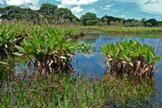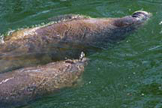First in Flyways
The Greater Fort Lauderdale Flyway Cities Coalition, a collaboration of the NatureScape Broward program, the National Wildlife Federation and 60 community partners, works to improve and expand habitat for migratory and resident wildlife in Broward County. Flyways are annual routes traveled by birds that migrate from wintering grounds in the south to breeding grounds in the north. They provide stopover points offering food, shelter and areas of congregation. In Broward County, the flyways concept has been expanded to include waterways, or “blueways” used by marine animals, such as manatees and sea turtles. Population growth, urban development and the effects of global climate change are expected to create additional challenges for resident and migratory wildlife as ecological zones shift and critical habitat is further diminished. Through the Flyways Coalition, the County and its partners are exploring ways to create and/or maintain tracts of land that are connected and conducive to wildlife migration. For more information, contact Diana Guidry at 954-519-0317.
County's Commitment to Environmental Protection and Conservation
Broward County Government initiated the implementation of energy efficiency and conservation measures. Recognizing the need for government operations efficiencies, the implementation of cost effective efficiency measures, and responsible fiscal policies, the County took a proactive leadership role to make a commitment for sustainability. Some of the measures implemented include:
- Policy to adopt LEED construction standards for all new County facilities
- Use of new hybrid electric transit buses, and alternative fuels in the County’s fleet
- Energy efficient retrofits of libraries, the airport, the port, traffic signals, wastewater facilities, courthouses, and other county facilities
- Partnership with the U.S. EPA WasteWise Program to reduce waste and promote recycling
- Energy efficient personal computer replacement program
- Paperless County Commission agenda preparation process
- Adopting paperless, electronic inspections
- County employee educational programs to conserve energy, fuel and water, and reduce waste generation
For more information on the county government initiatives visit the Government Operations Workgroup.
Integrated Plan for Water Resource Management
The County-wide Integrated Water Resources Plan (IWRP) is implemented by the Broward County Natural Resources Planning and Management Division, in partnership with local governments, water providers and managers. The IWRP focuses on coordination and cooperation in the management of water resources. Elements include water resource assessments, development of technical planning and decision-making tools, development and implementation of diverse traditional and nontraditional water management strategies, and a comprehensive water conservation outreach and education program. Through the IWRP, the County is finding ways to better utilize its existing canal infrastructure to move water to areas where it can be used to recharge groundwater supplies, rehydrate urban wetlands, and prevent saltwater intrusion. The program also provides matching grants to municipalities, utilities and water control/drainage districts to support the development of water resource projects. For more information, contact Robert Rudolph at 954-519-0328.
Broward Leads Nation in Wildlife Habitat Certification
In 2005, Broward County was the first county in the country to be certified by the National Wildlife Federation as a Community Wildlife Habitat. A Community Wildlife Habitat is a community that provides habitat for wildlife throughout the community--in individual backyards, on school grounds and in public areas such as parks, community gardens, places of worship and businesses. Since receiving this certification, the County has provided assistance to a number of Broward municipalities also seeking this designation. Coconut Creek, Lighthouse Point, Parkland, Plantation, Pompano Beach, and Wilton Manors are also certified Community Wildlife Habitats. Coral Springs, Davie, Deerfield, Hallandale Beach, and Oakland Park are registered and seeking certification. For more information, contact Diana Guidry at 954-519-0317.
Local Collaborative Seeks Solutions to Water Resource Issues

The Broward Water Resources Task Force convened in 2008 to regional and sub-regional alternative water supply strategies and water conservation solutions for Broward County. The Task Force includes the participation of 15 Broward elected officials and the support of a 21-member Technical Team. Efforts have included re-estimates of future water demands, evaluation of existing and planned water supply projects and development of recommendations in the areas of water conservation, alternative water supply projects, reuse planning and development, and research and investigations. In 2010, the Task Force completed its Final Report and now oversees implementation of recommended initiatives. The Broward Leaders Water Academy represents another effort to address regional water resource issues. Launched in 2008 and offered again in 2011, the Broward Leaders Water Academy provides elected officials and business leaders with a comprehensive study in water policy and water supply planning to better inform growth management and investment decisions. For more information, contact Karen Moore at 954-519-0356.
Airport Green Belt Serves Many Purposes
The southern boundary of the Fort Lauderdale-Hollywood International Airport is a 30-acre passive park and noise barrier. The earthen berm contains diverse vegetation and wetlands areas.
Group Seeks Water Quality Improvements for Everglades
 The Broward Everglades Working Group was created by Broward County Natural Resources Planning and Management Division and the South Florida Water Management District. Its mission is to support Everglades restoration through water quality improvements in the C-11 West Basin, with a focus on phosphorus pollution that is present in landscape and stormwater runoff. Phosphorus supports the growth of undesirable, fast-growing cattails that displace sawgrass, disrupt the flow of water in the Everglades and prevent foraging by wading birds. Representatives from state agencies, municipalities, drainage districts, the nursery industry, and others meet quarterly to review progress. For more information, contact Toni Edwards at 954-519-0356.
The Broward Everglades Working Group was created by Broward County Natural Resources Planning and Management Division and the South Florida Water Management District. Its mission is to support Everglades restoration through water quality improvements in the C-11 West Basin, with a focus on phosphorus pollution that is present in landscape and stormwater runoff. Phosphorus supports the growth of undesirable, fast-growing cattails that displace sawgrass, disrupt the flow of water in the Everglades and prevent foraging by wading birds. Representatives from state agencies, municipalities, drainage districts, the nursery industry, and others meet quarterly to review progress. For more information, contact Toni Edwards at 954-519-0356.
GreenSpace Broward Project Will Inventory Urban Forest
A new Urban and Commercial Horticulture program within the Parks and Recreation Division will inventory the urban forest of the County, including canopy trees and shrubs, to quantify replacement value, carbon storage, carbon sequestration, air pollution removal and energy savings. Partners include the University of Florida, Institute of Food and Agricultural Sciences School of Forest Resources and Conservation, and Broward County Environmental Protection and Growth Management Department. Contact jpipoly@broward.org.
Irrigation Service Saves Millions of Gallons of Water
The NatureScape Irrigation Service (NIS) is offered by the Broward County Natural Resources Planning and Management Division in cooperation with 18 municipal and water utility partners and the County’s Water and Wastewater Services Division. NIS offers irrigation system evaluations and recommendations for improving irrigation system efficiency and operation, particularly on larger properties where irrigation demands are the greatest. NIS-related improvements result in water and energy savings, and the improved health of turf grass and landscape plants. Since NIS is focused on delivering only the amount of water that can be effectively used by plants in the landscape plus typical losses to evaporation, many of the problems associated with inefficient and excessive irrigation are reduced, further reducing demand for fertilizers and other lawn care products, producing environmental and cost savings. Since the program began in 2005, NIS has saved over 685 million gallons of water. For more information, call 954-519-1281.
Port Everglades is Good Steward of the Environment
 Port Everglades has a history of environmental stewardship, including the donation of 35 acres to surrounding parks for the creation of now thriving wetlands. The Port has also dedicated over 4 acres of land to the not-for-profit Wildlife Care Center, enabling that facility to add a modern hospital for injured birds and other wildlife.
Port Everglades has a history of environmental stewardship, including the donation of 35 acres to surrounding parks for the creation of now thriving wetlands. The Port has also dedicated over 4 acres of land to the not-for-profit Wildlife Care Center, enabling that facility to add a modern hospital for injured birds and other wildlife.
The Port has invested more than $10,000 in waterway signage to alert recreational boaters to use caution in areas where manatees congregate. A protective grating system has been put in place on storm drains in shallow-water areas to help prevent manatees from getting caught. Trained observers maintain daily logs of manatee activities during dredging projects.
Port Everglades also supports programs for sealife-sustaining offshore artificial reefs, including providing more than $500,000 in free berthing for vessels engaged in such efforts.
Two Grant-Funded Programs to Help Environment
 The Natural Resources Planning and Management Division has initiated the Land Stewardship Program, a five-year capital improvements program which will oversee two programs funded by grants.
The Natural Resources Planning and Management Division has initiated the Land Stewardship Program, a five-year capital improvements program which will oversee two programs funded by grants.
The first is the ecological restoration of natural lands within Broward County through “Partners in Preservation” Grant Program. This will provide $500,000 a year for five years for the removal of invasive non-native vegetation, and replanting with appropriate native plants on public properties in Broward County, which contain one or more defined native vegetative communities. The proposed maximum grant is $50,000 per project. Project applicants must have the financial means for perpetual follow-up maintenance.
The second grant program, “ Parks for People” will provide competitive, matching funds of $1,000,000 a year for five years. The proposed maximum grant is $75,000 per project and funds are for sites acquired through the 2000 Safe Parks and Land Preservation Bond program which meet the comprehensive site criteria. The program is proposed for five years, so cities can apply in future years for funding of those sites which do not presently meet the criteria. The funds are for reimbursement of “green” project components, such as sustainable site development, water savings, energy efficiency, materials selection, and environmental quality.
For additional information contact lsp@broward.org or visitwww.broward.org/naturalresources and click LAND STEWARDSHIP.
Mooring Buoy Program Saves Reefs

Since 1989, the Broward County Natural Resources Division (NRD) has worked with local environmental groups and the dive community to establish and maintain a successful mooring buoy program. The program started humbly with the installation of 10 moorings at Barracuda Reef, located offshore of the Dr. Von D. Mizell-Eula Johnson State Park (formerly John U. Lloyd State Park). The success of this initial effort to protect our local coral reefs from the harmful effects of anchor damage led to an expansion of the mooring buoy system. Today Broward County maintains 122 mooring buoy installations located at eight popular diving and fishing sites along the coast.
With a year-round boating climate and over 47,000 registered boats, Broward County's offshore resources face tremendous pressure. Three tracts of natural reef communities exist offshore with the outermost reef located within one mile of our shoreline. Because of the narrowness of the continental shelf off Broward County, user pressure from both divers and fishermen is concentrated in this area and deploying anchors can cause damage to corals and other benthic organisms.
The goal of the mooring buoy program is to lessen the harmful effects of anchor damage on the heavily used coral reef resource, helping to protect and conserve this environmentally and economically important natural resource for future reef users. To obtain the benefits that mooring buoys can provide in protecting coral reef habitats, a strong commitment must be made to finance and manage a comprehensive and long-term maintenance program.
For additional information visit: https://www.broward.org/NaturalResources/BeachAndMarine/Pages/MooringBuoyProgram.aspx
Coastal Cleanup is a Collaborative Effort

Each September, the staff in the Broward County Natural Resources Division (NRD) organize and facilitate the Ocean Conservancy's International Coastal Cleanup effort in Broward County. Natural Resources Division staff function as Site Captains for the event, organizing 12 cleanup sites within the coastal municipalities from Deerfield Beach to Hallandale Beach.
The Coastal Cleanup requires significant cooperation and coordination among the County, multiple private and public organizations, and the coastal municipalities. At each cleanup location, site captains register volunteers, distribute collection bags and other supplies, direct volunteers to specific areas, and confirm service hours for high school students.
The Coastal Cleanup is always a rewarding experience for all those who participate. Multiple benefits result, including dramatic reductions in unsightly and unsanitary trash on our beaches and dunes, opportunities for productive service hours for volunteers, and opportunities for businesses and organizations to contribute to a “green" event.
For more information, or to register, visit: https://www.broward.org/NaturalResources/BeachAndMarine/Pages/CoastalCleanup.aspx
Conservation Efforts Save Baby Sea Turtles

From March through October each year, the beaches of Broward County are used by threatened and endangered marine turtles for a most important part of their life histories. Starting in March, female marine turtles will come ashore at night to deposit clutches of eggs deep in the sand. After digging a hole up to two feet deep and burying her clutch of about 110 eggs, each female will return to ocean allowing the eggs to incubate. In about fifty days, the baby turtles will hatch out of the nest on their own try to make their way back to the ocean. Marine turtles have been reproducing this way for the last 110 million years.
There are three species of marine turtle that commonly nest on Broward's beaches. The most common is the threatened Loggerhead Turtle (Caretta caretta). Each female Loggerhead turtle will deposit an average of about 5 nests per year. Less common (but not less important) are the endangered Green turtles (Chelonia mydas) and Leatherback turtles (Dermochelys coriacea), which also regularly nest on our beaches. For the most up to date nesting information, visit: https://browardauthor/NaturalResources/BeachAndMarine/SeaTurtles/Pages/default.aspx
Because most of the beach in Broward County is fully developed, highly utilized, and well-lit at night, there is reduced potential for sea turtle eggs to successfully incubate and hatch naturally. The Broward County Sea Turtle Conservation Program hires contractors who are responsible for conducting a daily survey of all sea turtle activity on most beaches in the County from March 1 through September 30 each year. The surveys include recording the GPS location of each nest; noting the species responsible for each nest; finding and recording the locations of each non-nesting crawl (roughly half the crawls are “false" crawls); relocating nests that are in danger of being damaged or destroyed; rescuing injured live turtles; recovering and recording vital statistics for stranded dead animals; and conducting a night survey of the extent of artificial light visible from the beach along those beaches where municipal sea turtle lighting ordinances are in effect. Outreach and education programs are also delivered upon request and staff availability. These presentations often include detailing the aspects of the biology, behavior, and life histories of marine turtles; describing the Conservation Program and survey methodology and rationale; and working with municipal authorities to enforce the lighting ordinances where they exist, and to develop and adopt an appropriate lighting ordinance where one does not yet exist.
County Agencies Reduce Dependency on Print
After many years of producing printed publications, Broward County agencies are turning to technology and increasing their electronic communications through email and the Web site, www.broward.org. Cultural Quarterly, Parks and Recreation Division’s Highlights, Consumer Protection’s Educated Consumer newsletter and many other agency publications are now electronic only, saving money and environmental resources required to produce paper-based publications. Office of Public Communications converted its community magazine, Broward Shines, to a video magazine.
County Print Shop Goes Green With Environmentally-Friendly Presses
 The Broward County Print Shop is an environmentally friendly operation. All presses use soy-based ink and chlorine-free solutions. Paper comes from sustainable forests. The Print Shop’s computer-to-plate imaging printing system is 100 percent chemistry-free and uses recyclable metal plates for printing.
The Broward County Print Shop is an environmentally friendly operation. All presses use soy-based ink and chlorine-free solutions. Paper comes from sustainable forests. The Print Shop’s computer-to-plate imaging printing system is 100 percent chemistry-free and uses recyclable metal plates for printing.
